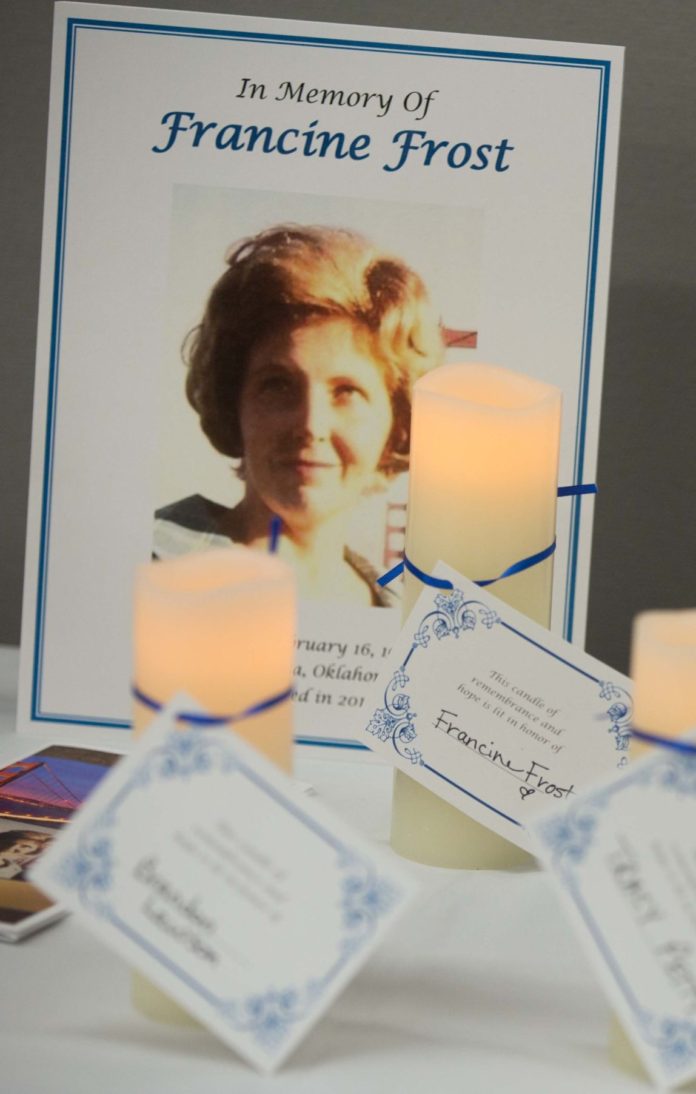NamUs
www.untfsu.com/NamUs/Overview.html
Fort Worth is quite a way from Tulsa, but for one family there the University of North Texas Health Science Center here held the resolution to a mystery that had haunted them for decades.
Francine Frost, 44, went missing from a Skaggs Alpha Beta grocery store parking lot in 1981, her keys dangling from her locked car door.
“I’ll never forget the phone call, the panic and the disbelief,” Vicki Curl, Frost’s daughter, told a crowd on June 4 at UNTHSC at a gathering hosted by the National Missing and Unidentified Persons System (NamUs). NamUs has been located at the school since 2011 as a national centralized repository and resource center for missing persons and unidentified decedent records.
NamUs is managed by UNTHSC and funded, with additional oversight, by the National Institute of Justice through cooperative agreement. NamUs is a free online system that can be searched by medical examiners, coroners, law enforcement officials and the general public to aid in resolving cases of missing or unidentified persons.
On June 4, NamUs and UNTHSC held an event where people could provide DNA, police reports, dental records, X-rays and other information to the database. Over a dozen people showed up, each seeking answers to a missing loved one or family member.
Among those searching was Glen Smith of Dallas. He and his family are searching for his stepdaughter, Amber Lynn Kidd. They last heard from the 38-year-old Kidd in October 2015. She had some mental and substance abuse issues but “always checked in,” Smith said. When they didn’t hear from her for three or four months, they knew something was wrong. Smith’s wife provided NamUs with a DNA sample, a simple swab from her cheek, in hopes of finding some answers.
“It’s tough,” Smith said, “not knowing.”
It was tough for the Frost family when Francine went missing in 1981. There was no trace of the woman, a mother and grandmother. Curl saw the impact it had on her family. Her sister, who was in college at the time, dropped out and eventually committed suicide. Curl puts much of the blame for that tragedy on the pain and stress from her mother’s disappearance.
“It was just compete sadness,” said Cory Curl, Vicki’s son, who also spoke to the group.
Computers, networking and DNA technology were still a few years away in 1981 when Frost disappeared. So, two years later, when the remains of an unidentified female were found two counties away in Muskogee County, no connection was made with the missing woman from Tulsa. The remains went unidentified for 33 years.
A breakthrough came in August 2013. It was part luck, part science. An Oklahoma medical examiner was changing offices and moving furniture when she came across a 1983 autopsy report for unidentified remains found in Muskogee County.
The medical examiner entered the report into the unidentified persons section of the NamUs database. Less than a year later, an online hobbyist on Webbsleuths connected the new unidentified persons entry in NamUs to Frost. In December 2014, Cory Curl was searching on his computer, still haunted by the case. He ran across the Webbsleuth entry on those unidentified remains in Muskogee County. The description of the shirt the victim was wearing matched that of the grandmother he barely knew.
“I knew it was her,” he said. “I can’t describe the feelings that came over me.”
The wheels in motion, Tulsa police notified the Frost family in August of 2016 that they had a match in the case. The body in Muskogee County was Francine Frost. According to reports on the case, Frost was shot multiple times and the death is considered a homicide. There are no suspects in the case, but there is at least a chance it can now be solved, said Curl, who encouraged other family members not to give up hope.
There are more than 950 missing people in Texas currently registered with NamUs. There are 60 missing persons entered into NamUs in Tarrant County.
There are more missing people than that in the county and the state and more should be entered into the NamUs database, says J. Todd Matthews, director of case management and communications for NamUs.
He wants more states to enact legislation similar to that passed by Tennessee recently. Signed into law in early May, the law requires authorities to enter every missing person into NamUs along with dental records. Connecticut and New Jersey have similar laws.
“I’d like to see a bill like that passed in every state,” said Matthews. “It would really help in identifying missing persons.”






